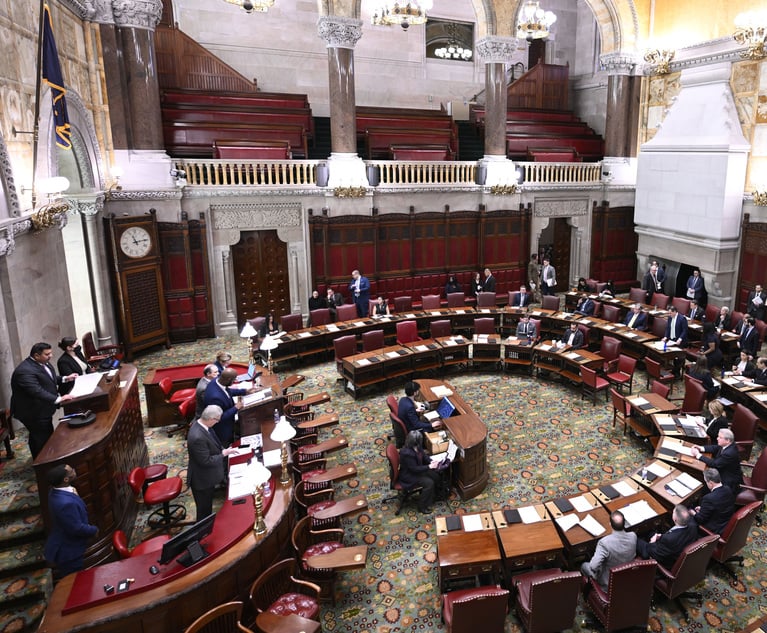Decisions in the 2016-2017 Term Overwhelmingly Favored Prosecutors
Paul Shechtman, a partner at Bracewell, writes: The 2016-2017 term of the New York Court of Appeals in criminal law was a relatively quiet one in which the prosecution fared better than the defense.
August 21, 2017 at 02:00 PM
39 minute read
The 2016-2017 term of the New York Court of Appeals in criminal law was a relatively quiet one in which the prosecution fared better than the defense.
'Brown'
In People v. Brown, 28 N.Y.3d 392 (2016), the Court decided a question that went unresolved two years ago in People v. Sibblies, 22 N.Y.3d 1174 (2014): If the People answer “ready” for trial off calendar and then are “not ready” at the next court appearance, do they bear the burden of showing that the statement of readiness was not illusory and therefore effective in stopping the speedy trial clock? The Brown majority held that a statement of readiness is “presumed … accurate and … a defendant who challenges such a statement must demonstrate that it is illusory.” The burden is on the defense. Writing separately, Judge Jenny Rivera disagreed, claiming that the majority's holding “turn[ed] the [§30.30] statute on its head.” She argued that the People should be charged with the time between the two statements “absent an explanation of how th[e] lapse in status [was] due to some exceptional fact or circumstance.”
Brown is the most significant speedy-trial decision in recent years. Had Judge Rivera's position prevailed, §30.30 dismissals would have increased, perhaps greatly. Take this example: Assume (1) the People answer ready off calendar today, and the case is next on in 30 days and (2) the People are not ready on the court date because the assigned ADA is on trial. The ADA's unavailability is not an “exceptional circumstance,” but nor is it reason to conclude that the off-calendar statement was a sham. Judge Rivera is correct, however, that the §30.30 statute often does more to encourage gamesmanship than speedy trials.
'Price'
People v. Price, 2017 N.Y. Slip. Op 05174 presented the Court its first opportunity to consider the authentication of Internet evidence, and the Court chose “to proceed with caution in a new and unsettled area of law.” Price was indicted for a gunpoint robbery of a milk delivery man. At trial, the People offered a “photograph that was found on the Internet,” which purportedly “depicted [Price] holding a handgun”—one that the victim testified looked “similar” to the gun used in the robbery. A detective testified that she found the photograph on the website “BlackPlanet.com” under a “public profile” with the user name “Price_OneofKind.” It was posted several months before the robbery. The individual in it, the detective testified, “looked similar” to Price.
That was all of the evidence linking Price to the site and the photograph. There was no reference to Price's full name on the profile page. Nor was any pedigree information offered to connect him to the page. And the detective could not say that the photograph was unaltered. On this record, the Court “assum[ed] without deciding” that a photograph could be authenticated by proof (1) that the website was “attributable to and controlled by the defendant” and (2) that the photograph was an accurate depiction of the page. Here, however, the authentication evidence was too “sparse” to meet that standard.
This content has been archived. It is available through our partners, LexisNexis® and Bloomberg Law.
To view this content, please continue to their sites.
Not a Lexis Subscriber?
Subscribe Now
Not a Bloomberg Law Subscriber?
Subscribe Now
NOT FOR REPRINT
© 2025 ALM Global, LLC, All Rights Reserved. Request academic re-use from www.copyright.com. All other uses, submit a request to [email protected]. For more information visit Asset & Logo Licensing.
You Might Like
View All
Relaxing Penalties on Discovery Noncompliance Allows Criminal Cases to Get Decided on Merit
5 minute read
SCOTUSblog Co-Founder Tom Goldstein Misused Law Firm Funds, According to Federal Indictment
2 minute read
Snapshot Judgment: The Case Against Illustrated Indictments

Read the Document: DOJ Releases Ex-Special Counsel's Report Explaining Trump Prosecutions
3 minute readTrending Stories
- 1SDNY Criminal Division Deputy Chief Returns to Debevoise
- 2Brownstein Adds Former Interior Secretary, Offering 'Strategic Counsel' During New Trump Term
- 3Tragedy on I-95: Florida Lawsuit Against Horizon Freight System Could Set New Precedent in Crash Cases
- 4Weil, Loading Up on More Regulatory Talent, Adds SEC Asset Management Co-Chief
- 5Big Banks Did Great Last Year. What Does That Mean for Big Law?
Who Got The Work
J. Brugh Lower of Gibbons has entered an appearance for industrial equipment supplier Devco Corporation in a pending trademark infringement lawsuit. The suit, accusing the defendant of selling knock-off Graco products, was filed Dec. 18 in New Jersey District Court by Rivkin Radler on behalf of Graco Inc. and Graco Minnesota. The case, assigned to U.S. District Judge Zahid N. Quraishi, is 3:24-cv-11294, Graco Inc. et al v. Devco Corporation.
Who Got The Work
Rebecca Maller-Stein and Kent A. Yalowitz of Arnold & Porter Kaye Scholer have entered their appearances for Hanaco Venture Capital and its executives, Lior Prosor and David Frankel, in a pending securities lawsuit. The action, filed on Dec. 24 in New York Southern District Court by Zell, Aron & Co. on behalf of Goldeneye Advisors, accuses the defendants of negligently and fraudulently managing the plaintiff's $1 million investment. The case, assigned to U.S. District Judge Vernon S. Broderick, is 1:24-cv-09918, Goldeneye Advisors, LLC v. Hanaco Venture Capital, Ltd. et al.
Who Got The Work
Attorneys from A&O Shearman has stepped in as defense counsel for Toronto-Dominion Bank and other defendants in a pending securities class action. The suit, filed Dec. 11 in New York Southern District Court by Bleichmar Fonti & Auld, accuses the defendants of concealing the bank's 'pervasive' deficiencies in regards to its compliance with the Bank Secrecy Act and the quality of its anti-money laundering controls. The case, assigned to U.S. District Judge Arun Subramanian, is 1:24-cv-09445, Gonzalez v. The Toronto-Dominion Bank et al.
Who Got The Work
Crown Castle International, a Pennsylvania company providing shared communications infrastructure, has turned to Luke D. Wolf of Gordon Rees Scully Mansukhani to fend off a pending breach-of-contract lawsuit. The court action, filed Nov. 25 in Michigan Eastern District Court by Hooper Hathaway PC on behalf of The Town Residences LLC, accuses Crown Castle of failing to transfer approximately $30,000 in utility payments from T-Mobile in breach of a roof-top lease and assignment agreement. The case, assigned to U.S. District Judge Susan K. Declercq, is 2:24-cv-13131, The Town Residences LLC v. T-Mobile US, Inc. et al.
Who Got The Work
Wilfred P. Coronato and Daniel M. Schwartz of McCarter & English have stepped in as defense counsel to Electrolux Home Products Inc. in a pending product liability lawsuit. The court action, filed Nov. 26 in New York Eastern District Court by Poulos Lopiccolo PC and Nagel Rice LLP on behalf of David Stern, alleges that the defendant's refrigerators’ drawers and shelving repeatedly break and fall apart within months after purchase. The case, assigned to U.S. District Judge Joan M. Azrack, is 2:24-cv-08204, Stern v. Electrolux Home Products, Inc.
Featured Firms
Law Offices of Gary Martin Hays & Associates, P.C.
(470) 294-1674
Law Offices of Mark E. Salomone
(857) 444-6468
Smith & Hassler
(713) 739-1250






